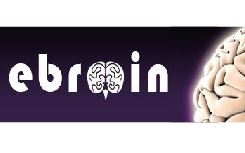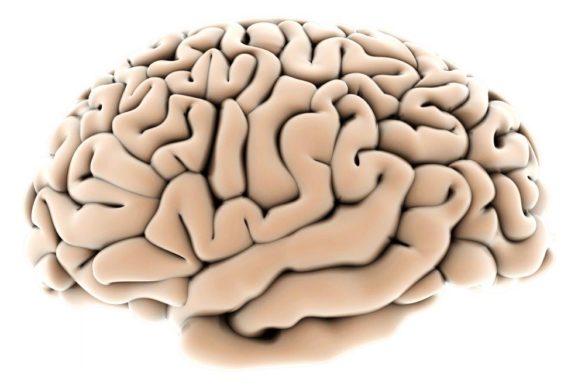by Svein Ivar Bekkelund
A 29-year-old man with a history of moderate autism and diabetes mellitus treated with insulin presented with a 2-week history of malaise, progressive pareses in both legs and slight weakness in both arms. The last two days before admission in the ward, he was unable to walk. Clinical neurological examination revealed grade 3 weakness in both arms and almost complete paralysis in the legs. The sensory findings were normal. The tendon reflexes were hypoactive but the plantar response was extensor bilaterally. He had urine retention, but there were no clinical signs of encephalopathy. MRI showed multiple hyperintense lesions in the brain, both supra- and infratentorial (Figs 1 and 2) and a significant lesion at the C1 level of the spinal cord (Fig. 3). Most lesions were slightly to moderately gadolinium enhancing but none were expansive. Examination of the cerebrospinal fluid (CSF) showed 7 x 106/l mononuclear leucocytes, normal total protein (291 mg/l) level and 10 oligoclonal bands on isoelectric focusing. Computer tomography of the chest, abdomen and pelvis were normal. Additional blood samples including search for HIV, malignancy, borrelia, syphilis and autoimmune disorders were negative. Neuronal and aquaporine-4 antibodies were also negative.
Initially, he was treated with intravenous methylprednisolone 1g per day for 5 days, but he still deteriorated. He developed complete tetraplegia, loss of sensation to pinprick and vibration. Mentally he seemed unaffected and electroencephalogram (EEG) was normal. The tendon reflexes were still hypoactive.
Suspecting acute disseminated encephalomyelitis (ADEM), he was treated with five courses of plasmapheresis. During the treatment, he developed left-sided ptosis, diplopia and dysphagia. He also needed respiratory support.
A follow-up MRI showed reduced sizes of the previous lesions, but some new periventricular lesions appeared. A new spinal tap with CSF analysis did not reveal further information. Treatment with intravenous immunoglobulin, 2g/kg body weight over 5 days, resulted in no clinical improvement. The patient now was in need of a mobile respirator.
Treatment with mitoxantrone, 12mg per m2 body surface per month during 3 months follow-up was initiated and during the treatment, the clinical progression ceased but he remained tetraplegic, had dysphagia and was unable to breathe independently.
A new MRI showed regression of both intracerebral and intraspinal hyperintensities (Figs. 4-6). Tetraplegia with extensor plantar responses persisted; there was no spasticity.
Nerve conduction studies (NCV) and electromyography (EMG) were performed 12 weeks after admission. An axonal sensorimotor polyneuropathy was found and interpreted as indicating critical illness neuropathy.
Svein Ivar Bekkelund is Head of the Department of Neurology at the University Hospital of North-Norway, Tomasjord, Norway
Comment by the Editor – Gian Luigi Lenzi
I have tried to get comments on this case from eminent experts – without success. Therefore, I – as a Senior Neurologist in charge of a neurological ward – am now trying to comment on this patient.
At my department, I would have asked for the same examinations and tests and would have performed the same therapies in the same sequence. In conclusion, my theoretical patient would have become tetraplegic and unable to breath independently – Rankin Scale 4.
Who may suggest something different?
Competition is open!We would be glad, if the authors could give us an update on this patient.
Comment by Bernard Decard and Ralf Gold
In this challenging case report Bekkelund present a 29 year-old man with subacute onset of progressive neurological motor symptoms up to complete tetraplegia, severe sensory symptoms, and concomitant brain stem symptoms including respiratory insufficiency and dysphagia. Interestingly, while bilateral plantar responses were detectable, tendon reflexes were hypoactive on admission and encephalopathic symptoms were absent throughout. The MRI revealed new large T2 lesions, many of them contrast enhancing with affection of the brainstem and upper spinal cord. CSF showed inflammatory changes with evidence of oligoclonal bands (OCB) and mild (7/µl) increase of mononuclear leucocytes paired with normal protein levels. The diagnosis of ADEM was made and the patient received escalating immunotherapies with methylprednisolone, plasmapheresis, IVIg, and mitoxantrone.
Given the patient’s age, the absence of encephalopathic symptoms, appearance of new periventricular lesions in the follow-up MRI, evidence for OCBs and the poor clinical response to methylprednisolone and other immunosupressive therapies, we suggest to reconsider the working hypothesis of ADEM.The following questions remain open:
1) Did the CSF analysis include cell cytology and search for malignant cells? Although a CNS lymphoma would probably have responded to steroids and protein/glucose levels would typically be abnormal, it cannot be excluded.
2) Were there any anti-myelin antibodies detectable in the patient’s serum? Especially in childhood this shows a higher link with ADEM.
3) Did the physicians consider a stereotactic biopsy of a non-eloquent cerebral lesion?
4) Were infectious causes like listeriosis or tropheryma Whipplei excluded?
There might be some counterarguments regarding the diagnosis of ADEM in this case: Typically ADEM manifests during childhood or adolescence, whereas ADEM is rare among adults. CSF analysis of ADEM patients detected OCBs in about only 12.5% of cases and they often disappeared after treatment with methylprednisolone. As hypoactive reflexes were detectable on admission, one might speculate that the PNS was already affected prior to the intensive care treatment. In very rare cases there can also be an inflammatory process of the CNS and PNS like isolated vasculitis of the nervous system. Furthermore, there are individual cases described in the literature where Marburg variants of MS display severe demyelinating and axonal destruction of the CNS. Marburg variants typically also show serious or fatal disease courses with poor response to immunosuppressive therapies.
In cases of atypical presentation of inflammatory CNS diseases with acute or subacute onset and rapid deterioration of neurological symptoms even under immunosuppressive therapies, we would recommend (if possible) a stereotactic biopsy in order to clarify the histopathological nature of the CNS lesions and allow a possible therapeutic re-adjustment.Bernhard Decard and Ralf Gold are working at the Department of Neurology at St. Josef Hospital, Ruhr-University Bochum, Germany
Comment by Saša Šega Jazbec
Dr. Bekkelund presents an interesting case of a 29-years old autistic diabetic (treated with insulin) with subacute onset tetraplegia, respiratory insufficiency and brainstem signs (diplopia, ptosis and dysphagia). He believes that the patient has ADEM.
Onset and clinical course of the disease together with MRI findings (multiple enhancing hyperintense lesions supra- and infratentorial and a large one in spinal cord) are compatible with the diagnosis of ADEM; no response to corticosteroids, IVIG and plasmapharesis is, however, somewhat unusual for ADEM. In most cases of ADEM such treatment improves the clinical picture or at least stops the progression of the disease. Unusual for ADEM with such a malignant course is also the only slightly abnormal CSF with normal proteins, I would expect more cells (with some neutrophils), and elevated proteins.
OB are positive only in 10% of patients with ADEM.
I agree with dr. Decard that encephalopathy is common in ADEM, however its absence in this case does not exclude possible ADEM.
Regarding therapy all recommended and usually effective treatments in ADEM have been tried; I would only argue if mitoxantrone was really indicated.
Dr. Bekkelund claims that all autoimmune diseases have been excluded. I would like to ask if also antiphospholipid syndrome (APS) was excluded? Sometimes neurological manifestations and MRI findings in APS can be indistinguishable from ADEM and MS and these cases anticoagulant treatment can be effective.
I also agree with Dr. Decard that lymphoma could look alike, and in case of lymphoma lesions could decrease in size after coticosteroid treatment as in this case. Most probably biopsy of one of the lesions could clarify this interesting case.Dr. Saša Šega Jazbec, dr. sc., is associate Professor of neurology at the MS Center, Department of Neurological Diseases, Division of Neurology, University Clinical Center
Ljubljana, Slovenia











4 comments
The differentail diagnosis for this case:
1-Acute disseminated encephalomyelitis (ADEM).
2-CNS Lymphoma.
3-CNS vasculitis.
4-Chronic lymphocytic inflammation with pontine perivascular enhancement responsive to steroids (CLIPPERS).
5-Others
*Paraneoplastic disease
*Histiocytosis X
*Bickerstaff brainstem encephalitis
Futher imvestigations needed if possible
Brain Biopsy
Brain MRA
Neural autoantibody
Paraneoplastic markers
Regarding the treatment
I agree with what Dr.Bekkelund had done.
May I suggest also Rituxmab.
Dr.Mohammed ELSherif, Mansoura University,Egypt
probability of guillian barrie sydrome i agree is very strong in this case as stated by the authour
Possibility It may be from a virus in the ear. So virus encephalitis. The initial ear symptoms (no ear ache) can very subtle, almost unnoticeable sometimes for some people. Ear symptoms may only last a short time. Antivirus treatment would be needed with the steroids. Might be why symptoms progressed if no antivirus given with steroids. Clinical signs of encephalopathy, this can also be discrete to medical staff. Weakness in both arms, diplopia, periventricular lesions – this could possibly go with this theory.
Also some spinal symptoms with spinal lesion including bladder, numbness is lower extremities, PNS symptoms, mild breathing and occasional dysphagia could go with this theory. I understand in the patients case it was much more extreme.